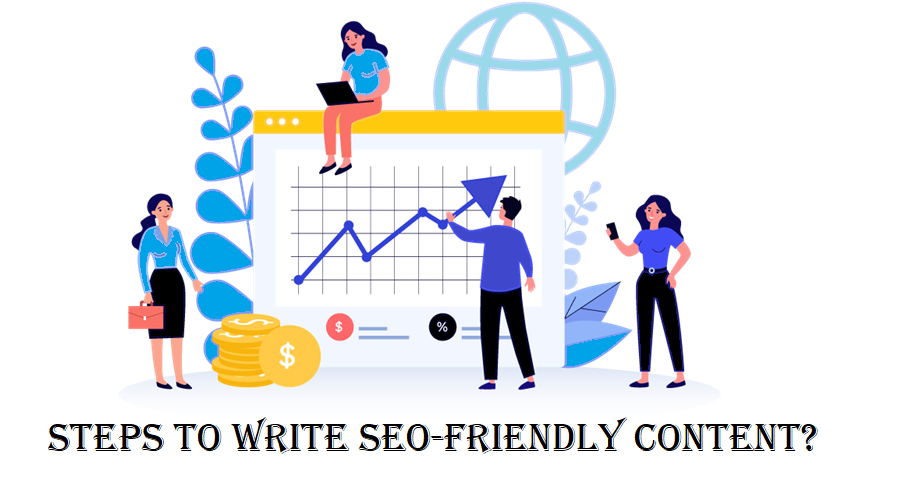Steps To Write SEO-Friendly Content?

Making your information accessible to both users and search engines is one of the most important things you can do for your website’s content.
Unfortunately, the process of creating content that is optimized for search engines often requires a lot of time and work. However, if you put in the work, you should be able to see the fruits of your labor in the end.
There is a widespread misunderstanding that information that has been optimized for search engines cannot also be user-friendly. This is a widespread misconception, as content that is well-optimized and of high quality boosts the likelihood of achieving a higher ranking on search engines.
This article is a collection of recommendations and tips for search engine optimization (SEO), and my intention is that using them can increase the visibility of your content within search results.
1. Keyword Research
——————————
Even though the current trend in SEO is to have people contribute thought-leadership content, keywords are still an extremely important part of SEO. Finding the most effective keywords to employ will enable you to dominate search engine results pages (SERPs) and win over the audience you are trying to reach.
Currently, the best paid tools for keyword research are Ahref or Semrush, while Google Keyword Planner is a free alternative.
The frequency with which a particular keyword was searched for over a given period of time is an important factor to consider when selecting your focus keywords. If you select the incorrect keywords, you will end up wasting both your time and your money.
It is essential to have a solid understanding of the searcher intent behind the keywords that you plan to use.
You can acquire the information you need and put it to use to create content that stands out in a competitive market by using the tools that are right there in the search results.
Consider employing the use of long-tail keywords. In spite of the little number of times they are searched for, they offer a strong potential to rank highly on the result pages of search engines (SERPs). People often use longer keyword phrases when they are looking for more specialized information because of this.
You may undertake in-depth keyword research for content that is optimized for search engines with the assistance of the following tools:
2. Content organization
——————————
If you want your content to stand out from the crowd, you should stick to a format that has been proven effective.
Determine initially what the primary emphasis of your post is. Writing can be made more productive by dividing up the work into sections. When your material is arranged, you may focus on each section individually without needing to first assemble your thoughts.
Each and every piece of writing needs an introduction, a body, and a conclusion. You are able to disassemble the body into its component parts and then fill those parts with writing that is reflective of who you are as a person and will appeal to the readers you have in mind.
It is essential to make the most of one’s conclusion, which is something that a lot of people fail to remember to do. Include a compelling call to action at the conclusion of your content in order to motivate readers to move forward with the next step.
Specifically, I found the West Coast Shipping Handbook to be helpful. They dissected the method of transporting an automobile into its six basic steps, then investigated each step in depth, including compelling calls to action.
3. Create interesting headings
——————————
The titles you choose to employ have a significant impact on both the search engine optimization and the usability of your website.
Blog post titles that are not only descriptive but also attention-grabbing tell readers exactly what they may anticipate learning from your writing, and they do so by drawing their attention to the topic at hand.
You might be able to boost your page ranks using titles that are optimized for SEO if you use these basic tactics.
Start your title with your target term
It is recommended that you keep the total number of characters in your title to no more than sixty. The first sixty characters of a query are all that are displayed by Google.
Take care to provide a comprehensive breakdown of the information contained in the post.
After you’ve thought of a catchy title, head on over to CoSchedule and check out how well it does there. The software generates an in-depth analysis for you that analyzes the grammar, readability, and length of your title. In addition, before sending an email, you may preview the search results on Google as well as the subject lines of emails.
Labels for use in headers
Increasing the accessibility of your content can be accomplished by subtitling it using captivating language. It is important to use a hierarchical structure while using subtitles.
There can only be one h1 element on each page, and it has to be used for the headline of the blog item. Additionally, it has to contain the keyword phrase that the page is optimizing for.
When heading the main parts of the document, you should use the h2 tag, and when heading the subheadings, you should use the h3 tag.
4. Optimize your URLs for search engines
——————————
When it comes to search engine optimization (SEO), having URLs that are both relevant and well-written is one of the most critical components.
According to Backlinko, URLs have a significant influence on the ranks that websites receive in search engines. The whole experience for the user is improved, and it is now much easier to distribute them.
You may create URLs that search engines will adore by following the rules that are provided below:
Make sure that the term you’re seeking to rank for is included on each page. As a direct consequence of this change, the capacity of the search engine to categorize and identify the page will be significantly improved.
To make your URLs shorter, get rid of any unnecessary words you may have included in them. A URL should include between 60 and 100 characters at the very most (three to five words).
If it is essential, separate the terms using hyphens. The following is an excellent illustration of what I mean:
- http://website.com/how-to-write-seo-friendly-posts/.
- Kindly write with only lowercase letters. If you type a URL using only capital letters, certain servers will either offer you a different URL or a 404 error.
- Avoid using a tonne of unnecessary words such as a but, and or in your writing.
- Make sure that your website’s URLs are not only simple to remember, but also fascinating and relevant.
- The website of Rosen Injury Lawyers serves as an example of an SEO-friendly URL structure. They have an appearance that is more streamlined, and they effectively zero in on the focus term.
5. Brief paragraphs are best
——————————
Make certain that your paragraphs are not too long.
Even though beginning each sentence on a new line is not required, paragraphs should be organized coherently and convey their own thoughts. Make use of brief paragraphs (about 2-3 sentences).
Experiment with a number of different fonts and sizes, add some bullet points, and emphasize the most important sentences. Your content will be more pleasurable to read as a result, and it will be easier to read on mobile devices.
6. Meta description needs to be improved
——————————
Google will display the meta description, which is effectively a summary of your content, directly under the title of your page in the search results. This is done with the help of the meta description.
If you want people to read the post you write for your blog, you need to make it fascinating as well as useful.
The meta description of your article has to include a synopsis of its content, as well as the keywords you want to rank for. It is advised that the length of the meta description be between 155 and 160 characters.
You shouldn’t just assume that the meta description you labored over and crafted will show up in the search engine results after all of your hard work.
Therefore, once you’ve identified your target keyword, you should incorporate it into your meta description in the most natural way possible.
If Google locates a match in your meta description, it will give your tag a higher chance of being used.
7. Boost the image quality
——————————
When integrated correctly and optimized, images have the potential to significantly improve both the readability of your content and the overall quality of the user experience. The method of optimizing an image is quite comparable to the process of optimizing content for a search engine in general.
Google Photos is unable to read the language that is included within photographs; nevertheless, it is able to analyze the context of an image to determine where it should rank in the results of a search.
It is essential to provide accurate Alt text as well as meaningful titles, filenames, and captions for any images that you upload.
The ALT text is hidden from site visitors, but it assists search engines in better understanding the context of images on a website. In the event that an image is unable to load for whatever reason, the alternate text will be shown instead.
Ensure that the alternative text (ALT text) of your photos is not only helpful and informative, but also makes use of your major keywords in an organic manner whenever it can.
8. Integrate appropriate links
——————————
In each new item that you post to your blog, you should include terms, facts, or points that could benefit from some more explanation.
This suggests that you shouldn’t hold back on inserting pertinent internal and external links into your content at any point during the process.
They provide your readers with the opportunity to explore further into a topic without causing them to lose track of your primary message.
Internal links are a great tactic to implement if you want to boost the search engine rankings of your website, encourage visitors to spend more time on your site, and reduce the percentage of site visitors who immediately leave after arriving there. It is possible to improve one’s site’s credibility and the overall user experience by including links to third-party websites that are considered reliable, such as Wikipedia.
You should also use anchor text that explains the topic of the link so that readers may determine whether they want to click on it. If at all feasible, keep the number of connections to a manageable level. No one can advise you on the optimal number of connections you should have.
Be sure that the stuff you link to is appropriate for your readers and that it offers something of value to them.
9. There must be a balance between content length and user intent
——————————
The optimal word count for the typical blog post is between 500 and 600 words.
This is because likes and shares on social media are more likely to occur on longer pieces of material, which in turn causes Google to favor longer pieces of information.
This indicates that lengthier postings have a greater chance of being found in a search because they have more characters.
Aim for roughly two thousand words as the optimal length for your article. Although aiming for a word count of 2,000 shouldn’t be your major focus, you should still try to reach that goal.
Because this is ultimately what people are searching for when they conduct a search, you should make the production of high-quality content that satisfies the needs of your readers and provides answers to the issues they have your top priority when you first get started.
There is no such thing as having an excessive amount of quality. Check out which articles are getting the most page views, and think about how the length of the content influences its overall success.
10. Make sure your Content is mobile-friendly
——————————
The use of mobile and tablet devices to access the internet is currently at 56% worldwide.
Because Google now ranks mobile-friendly websites higher, it is absolutely necessary for you to optimize your blog for mobile devices in order to get the best results.
Because Google now penalizes websites that are not mobile-friendly, having a website design that is responsive is absolutely necessary.
Your website needs to be responsive, which means that it should look well when viewed on PCs, smartphones, and tablets.
The uncomplicated look and feel of the website, which makes it simple to navigate and provides quick access to any and all material, contributes to the site’s user-friendliness.
As a result of this, you need to verify the amount of time it takes for your website to load.
Utilizing Accelerated Mobile Pages allows you to provide content that loads quickly and improves the overall experience for the user. For a good example of how to optimize a mobile-friendly website, you can check Futbolred, a widely used website in Colombia.
It is recommended that you make use of the SE Ranking Website Audit tool in order to locate and address any issues that may be present on your website. These issues may include issues relating to load time, mobile friendliness, correct HTML, and others.
The application does an analysis on vital parameters and makes recommendations for improvements when necessary.
Conclusion
It will take some work to figure out how to generate content that search engines enjoy, but the results will make the investment more than worthwhile in the long run.
By adhering to these procedures, you will increase the effectiveness of your copywriting efforts and move up higher in the results provided by search engines.
If you take their recommendations into consideration, there is a better chance that your content will be shared, that you will generate leads, that you will attract links, and that you will bring in new visitors.
I was wondering if there was anything more you could think of that might assist in making my content more search engine friendly. If this is the case, I would appreciate it if you could express your comments in the comment area.




